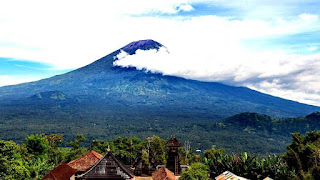Mount Agung, a volcano on the island of Bali in Indonesia, erupted multiple times in late November 2017, causing thousands to evacuate and disrupting air travel. As of 27 November 2017, the alert level was at its highest and evacuation orders were in place.
Tectonic earthquakes from the volcano had been detected since early August, and volcanic activity intensified for several weeks before decreasing significantly in late October. A second, more violent period of major activity began in late November.
Video 2017-2018 eruptions of Mount Agung
Background
1843 eruption
Agung erupted in 1843 as reported by Heinrich Zollinger:
After having been dormant for a long time, this year the mountain began to be alive again. In the first days of the activity earthquake shocks were felt after which followed the emission of ash, sand and stones.
1963 eruption
Mount Agung's 1963 eruption was among the most catastrophic volcanic events in Indonesian history. After initial explosions in the crater on 18 February of that year, lava began flowing down the mountain on 24 February, eventually traveling 7 km over the next three weeks. On 17 March, a highly explosive eruption occurred, reaching a VEI (Volcanic Explosivity Index) of 5 and sending lethal pyroclastic flows at high speeds down the mountain's slopes, killing at least 1,500 people. Heavy rainfall mixed with ash from the eruption in the following days caused extensive lahars which killed about 200 more people. A smaller eruption occurred on 16 May, sending pyroclastic flows down the mountain once more, killing about 200 more people. By the time the eruptions ceased in early 1964, they had claimed about 1,900 lives, marking the event as the 8th deadliest volcanic eruption of the 20th century.
Since 1963, the population of Bali has nearly doubled. Mount Agung is therefore considered highly dangerous by Indonesian authorities. This concern was the primary reason behind their decision to evacuate more than 100,000 people in response to the surge in local tectonic activity in the latter half of 2017.
Maps 2017-2018 eruptions of Mount Agung
Major activity in 2017
August
Volcanic earthquakes were observed from 10 August 2017 and the intensity increased in the following weeks.
September
In September 2017, an increase of rumbling and seismic activity around the volcano made people raise the alert to the highest level and about 122,500 people were evacuated from their homes around the volcano. The Indonesian National Disaster Management Authority declared a 12-kilometer exclusion zone around the volcano on 24 September. A plume was observed on 13 September.
Evacuees gathered in sports halls and other community buildings around Klungkung, Karangasem, Buleleng, and other areas. The monitoring station is in Tembuku, Rendang, Karangasem Regency, where intensity and frequency of tremors were monitored for signs of the imminent large eruption.
The area experienced 844 volcanic earthquakes on 25 September, and 300 to 400 earthquakes by midday on 26 September. Seismologists have been alarmed at the force and frequency of the incidents as it has taken much less for similar volcanoes to erupt.
October
In late October 2017, the activity of the volcano decreased significantly, leading to lowering of the alert status on 29 October.
The alert level remained at 3 (out of 4) until the start of the second major activity period, and plumes were observed during this time.
November
21 November
There was a small phreatic eruption reported at 09:05 (UTC), with the ash cloud top reaching 3,842 metres (12,605 ft) above sea level. Thousands of people immediately fled the area, and over 29,000 temporary refugees were reported to be housed in over 270 locations nearby.
25 November
A magmatic eruption began early on Saturday morning. The resulting eruption plume was reported to rise about 1.5-4 km above the summit crater, drifting towards the south and dusting the surroundings with a thin layer of dark ash, leading some airlines to cancel flights bound for Australia and New Zealand. An orange glow was later observed around the crater at night, confirming that fresh magma had indeed reached the surface.
26 November
At 23:37 (UTC), another eruption occurred. Ngurah Rai International Airport was closed next day, leaving many tourists stranded. More than 100,000 people in a 10-kilometre (6.2 mi) radius of the volcano were ordered to evacuate.
27 November
Sunday 26 November's eruption continued at a constant rate, and lahars were reported in the Selat district south of the volcano. The Australian Government's Bureau of Meteorology reported that the top of the eruption column had reached an altitude of 9,144 m (5.7 miles). Ash continued to spread in a southeasterly direction, and estimates by the Pacific Disaster Center predicted that the resulting atmospheric ash exposure will affect up to 5.6 million people within the densely populated region surrounding the volcano.
29 November
Reductions in eruption intensity and wind dispersal of the ash cloud led authorities to reopen Ngurah Rai International Airport at 07:00 (UTC). Authorities also warned that the eruption volume could increase again at any time, potentially shutting down air traffic once more.
Activity in 2018
January
The volcano erupted once again on January 11, sending plumes of smoke and ash, while Indonesia's Bali international airport was declared safe, operating normally. The eruption column was reported to rise 2.5 km above the mountain.
Impact
The 2017 eruption caused some 40,000 people to be evacuated from 22 villages around Mount Agung. It also caused surrounding airports to be closed. Lombok International Airport, on the neighboring island of Lombok, closed on 26 November, but was reopened the next morning, only to be closed again on 30 November. Lombok's airport reopened on 1 December. Ngurah Rai International Airport, located at the southern tip of the island and southwest of the volcano, closed on 27 November. More than 400 flights were canceled and about 59,000 passengers remained grounded. The airport was reopened on 29 November. This eruption also caused a decline in tourism on Bali by about 30%.
References
Source of the article : Wikipedia

